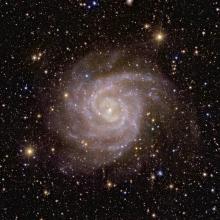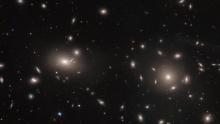Listen to today's episode of StarDate on the web the same day it airs in high-quality streaming audio without any extra ads or announcements. Choose a $8 one-month pass, or listen every day for a year for just $30.
You are here
Milky Way Halo
The disk of our home galaxy, the Milky Way, is enormous. It spans a hundred thousand light-years or more, and contains hundreds of billions of stars. Most of what makes up the galaxy, though, lies outside the disk. All of it is faint and thinly spread, and most of it is invisible.
This region of the galaxy is known as the halo. It appears to be shaped like a ball, with material distributed fairly evenly throughout its volume.
Quite a few stars inhabit the halo, though not nearly as many as in the disk. Almost all of them are extremely old. Hot, bright stars live short lives, so any that were born in the halo have long since expired. That leaves only stars that are less massive than the Sun — stars that are cool and faint. Many of them live in large, massive balls known as globular clusters.
The halo also contains a huge amount of hot gas. Some studies have said the amount may be equal to the mass of the entire disk.
But the halo’s main constituent isn’t visible to any telescope. It’s dark matter. It produces no detectable energy of any kind. We know it’s there, though, because it exerts a gravitational pull on the material we can see. It probably consists of subatomic particles. So far, though, efforts to discover these particles have been fruitless. Even so, dark matter may account for 85 percent of the galaxy’s mass — making the Milky Way a true heavyweight among galaxies.
Script by Damond Benningfield





